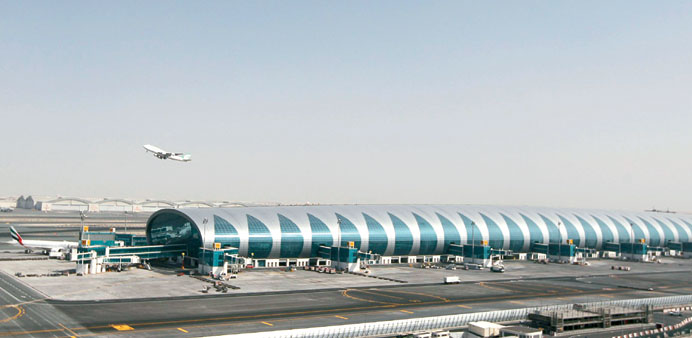Dubai Airports said it is in advanced talks with several airlines about bringing passenger traffic into a second airport as it begins the transition from the existing hub that will run out of space within the decade.
The airport authority may make an announcement on operators in coming weeks, said chief executive officer Paul Griffiths. Dubai World Central, as the new airport closer to the centre of the city is called, will have capacity by 2027 for 80mn passengers, and eventually grow to 160mn, more than double at London Heathrow International.
Dubai’s rulers have sought to exploit the emirate’s geographic position at the heart of intercontinental flight paths to develop an airport that can help local carrier Emirates win a higher share of long-haul traffic. Since Griffiths joined from London’s Gatwick Airport in 2007, Dubai International airport has almost doubled traffic to 57.7mn passengers, putting it on a path to match Heathrow by the end of 2013.
“When I started, Sheikh Ahmed gave me the objective to make sure nothing constrained the aviation industry,” Griffiths said in an interview in Berlin on March 5. “It’s nice to have one clear objective.”
A third of the world’s population lives within three hours flying distance from Dubai, and two thirds lives within eight hours, according to Griffiths, making the location optimally placed to serve global traffic intersections.
Emirates and all other passenger airlines operating in Dubai now fly in and out of Dubai International airport. The airport boasts three terminals and is undergoing a $7.8bn expansion plan that will boost capacity to 90mn passengers by 2018. Part of that project involved the construction of an area specially dedicated to the Airbus A380, the world’s largest passenger aircraft.
The A380 concourse, the world’s first facility built solely for the superjumbo, opened on January 2 and exclusively serves the doubledecker jets operated by Emirates, with the different travel classes segregated from the time they access the concourse. It may later take A380s operated by Qantas Airways Ltd, which has a partnership with Emirates, and may also take other big planes flown by Emirates, including Boeing Co 777s, Griffiths said.
Until now, the new airport has handled only freight operators. Its one runway will eventually expand to five parallel lines, and Dubai will add concourses to the point where it expects to have 120 aircraft movements an hour by about 2025. By comparison, Gatwick, Griffith’s alma mater, has less than half the amount of movements.
Emirates, whose CEO is Sheikh Ahmed bin Saeed al-Maktoum, isn’t going to switch over to the new airport before it reaches 80mn in passenger capacity because the airline’s mode is based on an integrated hub that lets customers connect to any other flight within 75 minutes, Griffiths said. Once the traffic has moved, the authorities will seek another use for the old facility, Griffiths said, without elaborating.
Even as the government-owned airport authority begins to move passenger airliners into the new facility, located 35km (22 miles) from the other site, Emirates will remain at Dubai International until it reaches saturation point, when it will switch over, Griffiths said.
The Dubai government is still weighing whether it makes more sense to accelerate a move from Dubai International to Dubai World, or to let it happen more slowly, Griffiths said.
“We’re looking at alternatives now, and in a few months we’ll have a clear position,” he said. “One plan is to build up quickly, within a 12-year frame. The other calls for longer, incremental growth over 15 years.”
Either way, operating both hubs simultaneously for some time poses its challenges, said Griffiths, whose previous career stints include work for Richard Branson’s Virgin Atlantic Airways Ltd.
“There are various equations,” he said. “Can you operate two airports, one of 160mn, one of 100mn passengers, within 35km and cope with these buzzing bees in the sky?”
Among the other challenges is devising a unified system to help manage the increased number of flights. Air traffic control in the Gulf region is still a mix of centres under individual, sovereign nations, requiring hand-offs for pilots as they pass from one air space to another. Still, going back to the low-growth pace of western European aviation is not an option, Griffiths said.
“In the developed western world, everything is well organised, everything is thought through and there are regulations for everything,” Griffiths said. “The unfortunate thing is, in mature societies, there are far more things you can’t do than you can do. In Dubai, I was allowed to paint the canvas with any brush and any colour.”
UAE central bank orders speedy review of mortgage, bank rules
The UAE central bank said yesterday it wanted to finalise a review of regulations on mortgages, banks’ loan exposure and liquidity to make sure they were put into practice quickly.
The central bank has imposed regulations to limit risk at UAE commercial banks three times over the past year, but has then backed off from enforcing them after complaints from the banks.
“The board instructed speedy finalisation of the review of all articles of the said regulations to expedite approval and ensure timely implementation thereof,” the central bank said in a statement.
Saeed Abdulla al-Hamiz, assistant central bank governor for banking supervision, said on Wednesday the central bank must act this year to push forward the previously issued rules and policies.
In January, the central bank said it would not enforce curbs on residential mortgage loans as a proportion of property values that it had set three weeks earlier.
Last year it announced rules limiting banks’ exposure to state-linked borrowers and rules requiring them to hold a certain ratio of their assets in the form of liquid instruments. Both initiatives were suspended in December after discussions with banks.
“The board also discussed a number of issues relating to liquidity levels and ratios aimed at achieving a sustainable balance between deposits and loans at banks operating in the UAE,” the central bank added yesterday.

